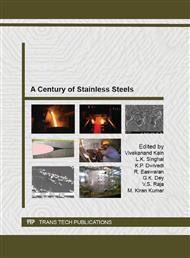p.222
p.230
p.238
p.248
p.257
p.274
p.289
p.305
p.316
Landmark Events in the Welding of Stainless Steels
Abstract:
This lecture presents the authors personal views on the landmark events that have strongly affected the welding of stainless steels over their lifetime. Although 1913 is commonly recognized as the birth of stainless steels with the commercialization of the martensitic alloy of Harry Brearly and the austenitic alloy of Eduard Maurer and Benno Straus, the story can be considered to begin as long ago as 1797 with the discovery of chromium by Klaproth and Vauquelin, and the observation by Vauquelin in 1798 that chromium resists acids surprisingly well. From the 1870s onwards, corrosion resisting properties of iron-chromium alloys were known. One might mark the first iron-chromium-nickel constitution diagram of Maurer and Strauss in 1920 as a major landmark in the science of welding of stainless steels. Their diagram evolved until the outbreak of World War II in Europe in 1939, and nominally austenitic stainless steel weld metals, containing ferrite that provided crack resistance, were extensively employed for armor welding during the war, based on their diagram. Improved diagrams for use in weld filler metal design and dissimilar welding were developed by Schaeffler (1947-1949), DeLong (1956-1973) and the Welding Research Council (1988 and 1992). Until about 1970, there was a major cost difference between low carbon austenitic stainless steels and those austenitic stainless steels of 0.04% carbon and more because the low carbon grades had to be produced using expensive low carbon ferro-chromium. Welding caused heat affected zone sensitization of the higher carbon alloys, which meant that they had to be solution annealed and quenched to obtain good corrosion resistance. In 1955, Krivsky invented the argon-oxygen decarburization process for refining stainless steels, which allowed low carbon alloys to be produced using high carbon ferro-chromium. AOD became widely used by 1970 in the industrialized countries and the cost penalty for low carbon stainless steel grades virtually vanished, as did the need to anneal and quench stainless steel weldments. Widespread use of AOD refining of stainless steels brought with it an unexpected welding problem. Automatic welding procedures for orbital gas tungsten arc welding of stainless steel tubing for power plant construction had been in place for many years and provided 100% penetration welds consistently. However, during the 1970s, inconsistent penetration began to appear in such welds, and numerous researchers sought the cause. The 1982 publication of Heiple and Roper pinpointed the cause as a reversal of the surface tension gradient as a function of temperature on the weld pool surface when weld pool sulfur became very low. The AOD refining process was largely responsible for the very low sulfur base metals that resulted in incomplete penetration. The first duplex ferritic-austenitic stainless steel was developed in 1933 by Avesta in Sweden. Duplex stainless steels were long considered unweldable unless solution annealed, due to excessive ferrite in the weld heat-affected zone. However, in 1971, Joslyn Steel began introducing nitrogen into the AOD refining of stainless steels, and the duplex stainless steel producers noticed. Ogawa and Koseki in 1989 demonstrated the dramatic effect of nitrogen additions on enhanced weldability of duplex stainless steels, and these are widely welded today without the need to anneal. Although earlier commercial embodiments of small diameter gas-shielded flux cored stainless steel welding electrodes were produced, the 1982 patent of Godai and colleagues became the basis for widespread market acceptance of these electrodes from many producers. The key to the patent was addition of a small amount of bismuth oxide which resulted in very attractive slag detachment. Electrodes based on this patent quickly came to dominate the flux cored stainless steel market. Then a primary steam line, welded with these electrodes, ruptured unexpectedly in a Japanese power plant. Investigations published in 1997 by Nishimoto et al and Toyoda et al, among others, pinpointed the cause as about 200 ppm of bismuth retained in the weld metal which led to reheat cracking along grain boundaries where the Bi segregated. Bismuth-free electrode designs were quickly developed for high temperature service, while the bismuth-containing designs remain popular today for service not involving high temperatures.
Info:
Periodical:
Pages:
257-273
Citation:
Online since:
September 2013
Authors:
Price:
Сopyright:
© 2013 Trans Tech Publications Ltd. All Rights Reserved
Share:
Citation:


